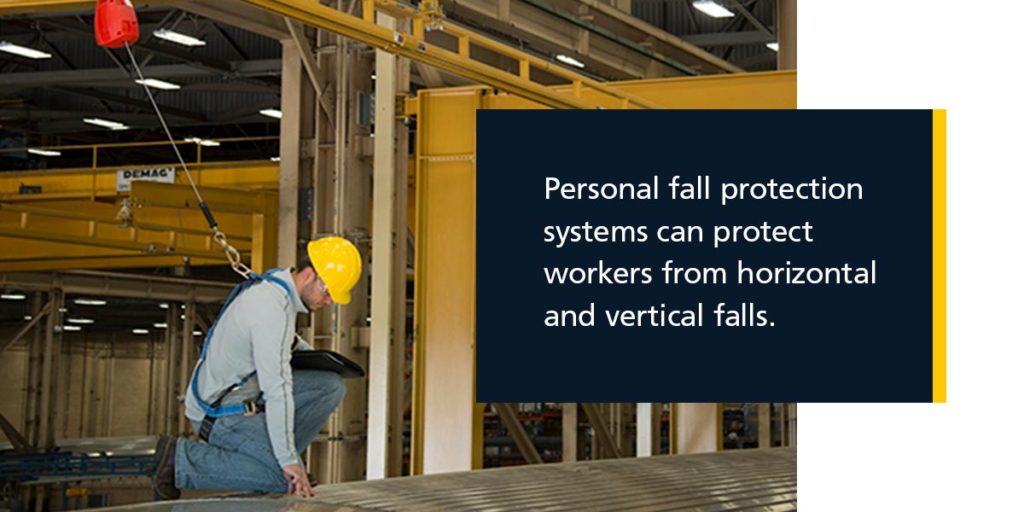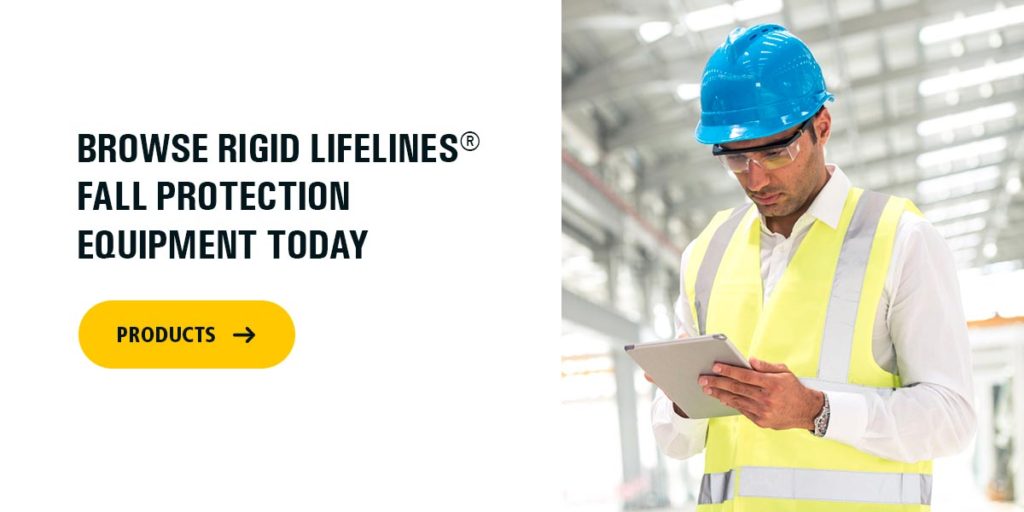
What Does a Personal Fall Arrest System Consist Of?
December 19, 2022
A personal fall arrest system is essential for workplace safety. The gear protects at-height workers by stopping a falling person from reaching the ground. OSHA requires personal fall arrest systems if there is any risk that a worker could fall from an elevated position. The system must also feature specifics installed by a qualified person to meet OSHA’s regulations.
The three components of a personal fall arrest system are an anchorage, a full-body harness, and a connecting device. Each feature must be in the correct position and secured properly to provide maximum protection for workers. Understanding these three components is essential for establishing a safer work environment.
Read on to learn more about the three personal fall arrest system features.
Full-Body Harness
A full-body harness, also called a safety harness, is the primary component of a personal fall arrest system. This type of safety gear distributes the fall’s impacts across different areas of the body, including:
- Thighs
- Pelvis
- Waist
- Chest
- Shoulders
It also ensures a worker will stand upright after a fall. The body harness must have a way to connect to other components of the protection system, such as anchorage points. Systems typically use D-rings, which are D-shaped metal rings, to link harnesses to the rest of the system. Harnesses can also contain extra D-rings for positioning, suspension, or fall prevention capabilities.
The full-body harness must meet other requirements set by the American Society of Safety Professionals like:
- D-rings on your harness must be able to withstand a 3.3-foot fall with a 220-pound test weight.
- Your D-ring must be suitable for rescue applications.
- The harness should limit the fall’s maximum arresting force to 1,800 pounds.
Anchorage Point
The second necessary feature of a PFAS is an anchorage point. Anchorages are secure attachment points for the systems’ connective devices, which are usually lifelines or lanyards. These components hold a worker during and after a fall. According to OSHA, anchorages must abide by these regulations.
- They must be high enough that a worker would avoid contact with a lower level in case of a fall.
- Anchorages need to support at least 5,000 pounds for each attached worker.
- A qualified person must supervise the anchorage’s design, installation, and use and ensure it maintains a safety factor of at least two.
- They need to minimize swing fall hazards.
A PFAS should also include an anchorage connector, which links a connecting device with the anchorage. For instance, an anchorage connector could link a lanyard with an anchorage.
Connecting Devices
Lastly, connective devices are the third essential feature of a PFAS. These tools connect the anchor point to the body harness, creating a complete arrest system. Connecting devices must always attach to the rest of the protection system, and workers must wear them at all times.
These tools must also abide by OSHA requirements like these.
- They must reduce arresting forces to a maximum of 1,800 pounds.
- Officials must calculate a potential fall distance and base the connector’s length on this measurement.
- They must connect to the body harness and anchorage with D-rings, snap hooks, or buckles.
The two connective means for protection fall arrest systems are lanyards and self-retracting lifelines. Here is a closer look at both options.
Fall Protection Lanyard
Lanyards are flexible lines of rope or synthetic straps that secure a full-body harness to an anchorage point. Many lanyards contain an energy-absorbing feature, which takes in energy during a fall, reducing the impact on a user’s body. Shock-absorbing lanyards are also available. These tools provide deceleration distance during falls.
OSHA regulations state that lanyards must:
- Have at least 5,000 pounds of minimum breaking strength.
- Be capable of holding a 3,000-pound tensile load when fully extended if they automatically limit free-fall distance.
- Be capable of holding a 5,000-pound tensile load when fully extended if they do not automatically limit free-fall distance.
- Have ropes or straps containing synthetic fibers.
Self-Retracting Lifeline
The other option for a connective device is a self-retracting lifeline. These devices also connect an anchorage to a safety harness. During use, SRLs reduce falling distance and resulting energy from a fall. The lifeline pulls out and retracts easily, allowing workers to move in an elevated position. During a fall, an SRL engages an internal braking system that halts a worker’s movement. Once the tension releases, the employee can move freely again.
SRLs and fall protection lanyards have a few differences.
- Length: Lanyards typically have a fixed length based on fall potential, while SRLs can lengthen and retract as needed.
- Activation time: SRLs can usually activate more quickly than fall protection lanyards.

Horizontal or Vertical Fall Arrest Support
Personal fall protection systems can protect workers from horizontal and vertical falls. A horizontal fall occurs on the level that a worker stands on, such as someone tripping while moving. Instead, a vertical fall happens between two different levels, like a worker falling from one location to another.
You can alter a personal fall arrest system to meet the specific needs of either fall type. Employees need proper fall protection in case a fall occurs in either circumstance.
Here are typical components of both fall types.
- Vertical fall protection: Workers use a vertical lifeline assembly to protect from vertical falls. This system includes a full-body harness, anchorage points, and connecting devices. The lifeline suspends vertically, in the direction a worker would travel during a fall. If needed, the protection system can also include shock absorbers or a tensioner component.
- Horizontal fall protection: A horizontal fall protection system contains a horizontal lifeline and anchorage connectors. The two anchorages have the same elevation. Like vertical ones, these systems can also have a shock absorber or tensioner feature.
OSHA also states that a qualified professional must install horizontal and vertical lifelines.

Browse Rigid Lifelines® Fall Protection Equipment Today
A personal fall arrest system consists of a full-body harness, an anchorage point, and a connecting device. These systems are crucial for protection against serious fall hazards. Whether you work in construction, manufacturing, or anything in between, your system must meet OSHA regulations and protect employees in case of a fall.
Rigid Lifelines is a leading provider of fall arrest and fall restraint equipment. For more than 20 years, we have researched, designed, and tested fall equipment to find the best protection for your workers. All of our systems comply with the necessary OSHA and ANSI regulations.
To get started with Rigid Lifelines, browse our fall protection products today.
Categories
Share this post
Let us help you
Contact us today to find the perfect product fit for your job
